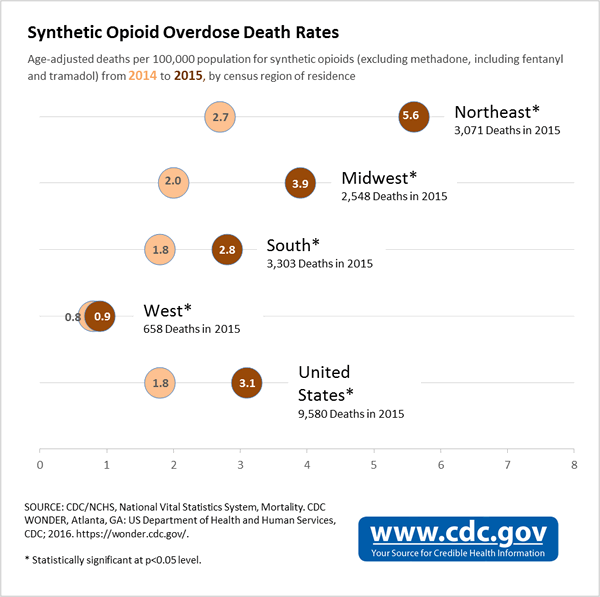Synthetic Opioid Data
Excluding methadone but including drugs like tramadol and fentanyl
What is Fentanyl?
Fentanyl is a synthetic (man-made) opioid that is 50x more potent than heroin and 100x more potent than morphine. There are two types of fentanyl:
- Pharmaceutical fentanyl, which is primarily prescribed to manage acute and chronic pain associated with advanced cancer.
- Non-pharmaceutical fentanyl, which is illicitly manufactured, and is often mixed with heroin and/or cocaine—with or without the user’s knowledge—in order to increase the drug’s effect.
The death rate of synthetic opioids other than methadone, which includes drugs such as tramadol and fentanyl, increased by 72.2% from 2014 to 2015.1 Synthetic opioid death rates (other than methadone) increased across all demographics, regions, and numerous states. Recent state reports have indicated that increases in synthetic opioid-involved deaths have been associated with the number of drug products obtained by law enforcement testing positive for fentanyl but not fentanyl prescribing rates. These reports indicate that increases in synthetic opioid-involved deaths are being driven by increases in fentanyl-involved overdose deaths, which are likely due to illicitly-manufactured fentanyl.2,3

Age-adjusted death rates for synthetic opioids, excluding methadone but including fentanyl and tramadol, are displayed above by census region for 2014 to 2015. Rates increased in all regions—107.4% in the Northeast, 95% in the Midwest, 55.6% in the South, and 12.5% in the West.1 The synthetic opioid overdose death rate also increased in the United States overall—a statistically significant 72.2% increase from 2014 to 2015, with a total of 9,580 deaths in 2015.1 Deaths were classified using the International Classification of Diseases, Tenth Revision (ICD–10). Drug overdose deaths are identified using underlying cause-of-death codes X40–X44, X60–X64, X85, and Y10–Y14. Drug overdose deaths were defined as having synthetic opioids excluding methadone (T40.4) as contributing causes. Age-adjusted death rates were calculated using the direct method and the 2000 standard population.1
References
- Rudd RA, Seth P, David F, Scholl L. Increases in Drug and Opioid-Involved Overdose Deaths — United States, 2010–2015. MMWR Morb Mortal Wkly Rep. ePub: 16 December 2016. DOI: http://dx.doi.org/10.15585/mmwr.mm6550e1.
- Gladden RM, Martinez P, Seth P. Fentanyl law enforcement submissions and increases in synthetic opioid-Involved overdose deaths - 27 states, 2013-2014. Morb Mortal Wkly Rep. 2016;65(33):837-43.
- Peterson AB, Gladden RM, Delcher C, Spies E, Garcia-Williams A, Wang Y, et al. Increases in fentanyl-related overdose deaths - Florida and Ohio, 2013-2015. Morb Mortal Wkly Rep. 2016;65(33):844-9.
- Page last reviewed: December 16, 2016
- Page last updated: December 16, 2016
- Content source:
- Centers for Disease Control and Prevention,
- National Center for Injury Prevention and Control,
- Division of Unintentional Injury Prevention


 ShareCompartir
ShareCompartir
